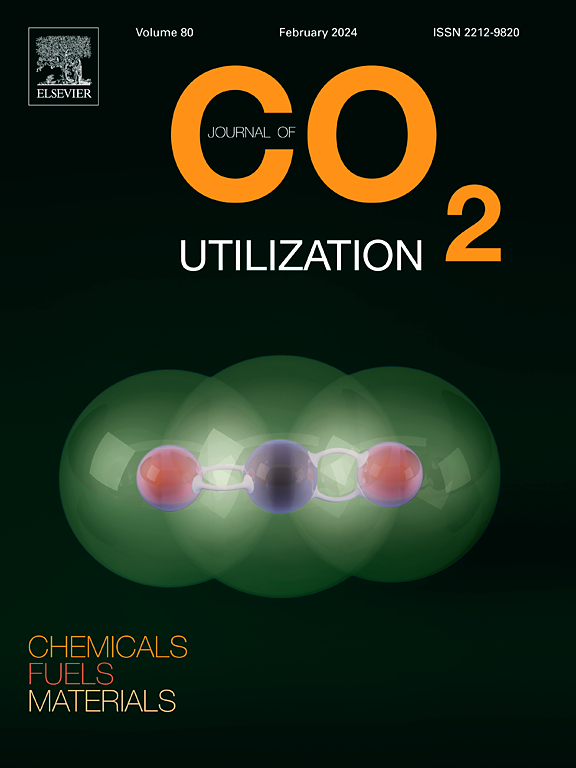动力制气应用中CO2甲烷化的热力学分析:原位除水对性能和热释放的影响
IF 8.4
2区 工程技术
Q1 CHEMISTRY, MULTIDISCIPLINARY
引用次数: 0
摘要
本研究对二氧化碳甲烷化进行了全面的热力学分析,旨在确定由复杂网络控制的反应的最佳操作条件。在Aspen Plus®中使用吉布斯自由能最小化进行模拟。系统地研究了关键变量,包括温度(200-500°C),压力(1,5,10和30 atm)和H2/CO2摩尔比(2:1,4:1,6:1)。特别关注选择性除水,在全范围内(0-100 %)进行分析,以模拟吸附增强和膜反应器系统。对于这些场景,H2/CO2的比例固定为4:1,以反映典型情况。考虑到CO2加氢的放热性质,还进行了热分析,以估计热量释放并评估热中性操作的可行性。在更大的温度范围(200-700°C)、相同的压力和进料比下进行了评估,从而深入了解了能源效率和运行稳定性。结果表明,脱水强烈地改变了热力学平衡,显著提高了CO2转化率和CH4选择性,达到一个临界点,超过这个临界点就有利于焦炭的形成。该最佳位置对温度和压力高度敏感,因此需要严格的操作控制。反应热分布的相应变化进一步强调了这些相关性。总的来说,这项工作为动力学复杂系统提供了详细的热力学视角,确定了有利的操作窗口,并突出了过程限制。这些发现补充了现有文献,为CO2甲烷化技术的设计和优化提供了有价值的指导。本文章由计算机程序翻译,如有差异,请以英文原文为准。
Thermodynamic analysis of CO2 methanation for power-to-gas applications: Impact of in-situ water removal on performances and heat release
This study presents a comprehensive thermodynamic analysis of CO₂ methanation, aimed at identifying optimal operating conditions for a reaction governed by a complex network. Simulations were performed in Aspen Plus® using Gibbs free energy minimization. Key variables were systematically investigated, including temperature (200–500 °C), pressure (1, 5, 10 and 30 atm), and H2/CO2 molar ratio (2:1, 4:1, 6:1). A special attention is given to selective water removal, analyzed across a full range (0–100 %) to simulate sorption-enhanced and membrane reactor systems. For these scenarios, the H2/CO2 ratio was fixed at 4:1 to reflect typical conditions. Given the exothermic nature of CO2 hydrogenation, a thermal analysis was also performed to estimate heat release and assess the feasibility of thermoneutral operation. This was evaluated over an extended temperature range (200–700 °C) and the same pressures and feed ratios, providing insights into energy efficiency and operational stability.
Results show that water removal strongly shifts the thermodynamic equilibrium, significantly increasing CO2 conversion and CH4 selectivity up to a critical point, beyond which coke formation becomes favorable. The location of this optimum is highly sensitive to temperature and pressure, highlighting the need for strict operational control. Corresponding variations in the reaction heat profile further emphasize these dependencies. Overall, this work offers a detailed thermodynamic perspective on a kinetically complex system, identifies favorable operating windows and highlights process limitations. These findings complement existing literature and provide valuable guidance for the design and optimization of CO2 methanation technologies.
求助全文
通过发布文献求助,成功后即可免费获取论文全文。
去求助
来源期刊

Journal of CO2 Utilization
CHEMISTRY, MULTIDISCIPLINARY-ENGINEERING, CHEMICAL
CiteScore
13.90
自引率
10.40%
发文量
406
审稿时长
2.8 months
期刊介绍:
The Journal of CO2 Utilization offers a single, multi-disciplinary, scholarly platform for the exchange of novel research in the field of CO2 re-use for scientists and engineers in chemicals, fuels and materials.
The emphasis is on the dissemination of leading-edge research from basic science to the development of new processes, technologies and applications.
The Journal of CO2 Utilization publishes original peer-reviewed research papers, reviews, and short communications, including experimental and theoretical work, and analytical models and simulations.
 求助内容:
求助内容: 应助结果提醒方式:
应助结果提醒方式:


